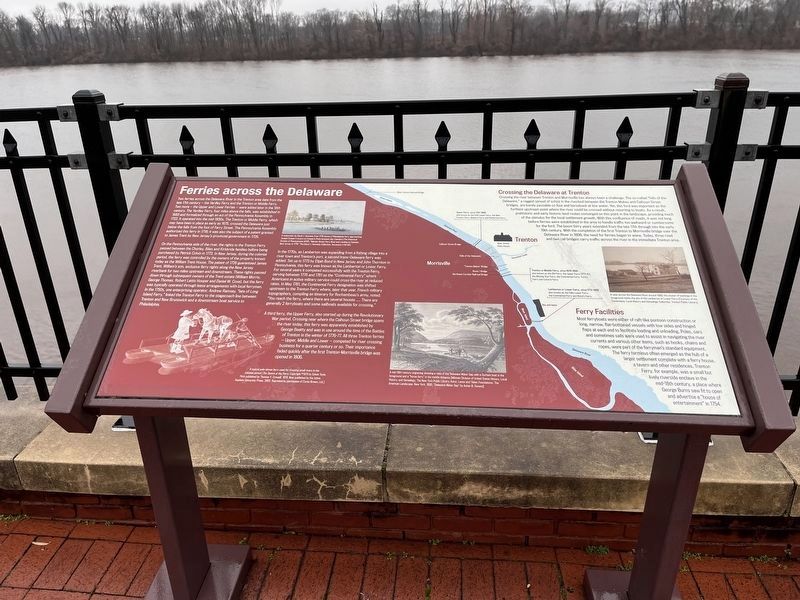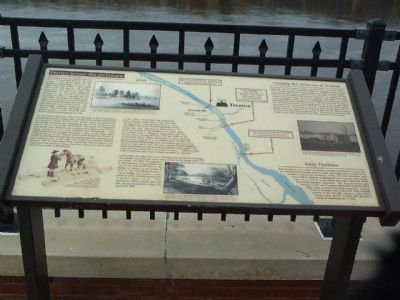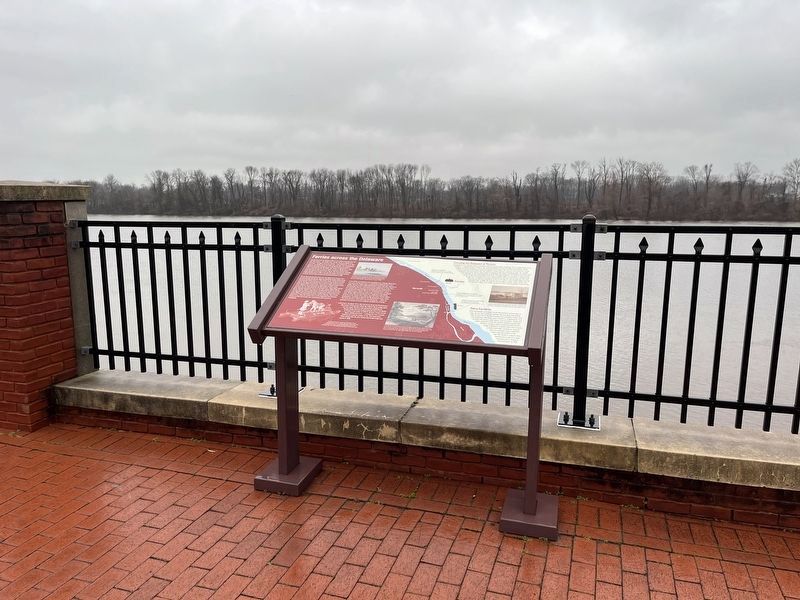South Trenton in Mercer County, New Jersey — The American Northeast (Mid-Atlantic)
Ferries across the Delaware
Two ferries across the Delaware River in the Trenton area date from the late 17th century – the Yardley Ferry and the Trenton or Middle Ferry. Two more – the Upper and Lower Ferries – were added later in the 18th century. The Yardley Ferry, four miles above the falls, was established in 1683 and formalized through an act of the Pennsylvania Assembly in 1722. It operated into the mid-1830s. The Trenton or Middle Ferry, which may have been in place as early as 1675, crossed the Delaware just below the falls from the foot of Ferry Street. The Pennsylvania Assembly authorized this ferry in 1718; it was also the subject of a patent granted to James Trent by New Jersey’s provincial government in 1726.
On the Pennsylvania side of the river, the rights to the Trenton Ferry passed between the Chorley, Biles and Kirkbridge families before being purchased by Patrick Colvin in 1772. In New Jersey, during the colonial period, the ferry was controlled by the owners of the property known today as the William Trent House. The patent of 1726 guaranteed James Trent, William’s son, exclusive ferry rights along the New Jersey riverbank for two miles upstream and downstream. These rights passed down through subsequent owners of the Trent estate (William Morris, George Thomas, Robert Lettis Hooper and Daniel W. Coxe), but the ferry was typically operated through lease arrangements with local ferrymen. In the 1750s, one enterprising operator, Andrew Ramsay, “late of Long Island Ferry,” linked the Trenton Ferry to the stagecoach line between Trenton and New Brunswick and a downstream boat service to Philadelphia.
In the 1770s, as Lamberton was expanding from a fishing village into a river town and Trenton’s port, a second trans-Delaware ferry was added. Set up in 1773 by Elijah Bond in New Jersey and John Thornton in Pennsylvania, this ferry was known as the Lamberton or Lower Ferry. For several years it competed successfully with the Trenton Ferry, serving between 1776 and 1781 as the “Continental Ferry” where Americans in active military service could cross the river at reduced rates. In May 1781 the Continental Ferry designation was shifted upstream to the Trenton Ferry where, later that year, French military topographers, compiling an itinerary for Rochambeau’s army, noted: “You reach the ferry, where there are several houses …. There are generally 2 ferryboats and some sailboats available for crossing.”
A third ferry, the Upper Ferry, also started up during the Revolutionary War period. Crossing near where the Calhoun Street bridge spans the river today, this ferry was apparently established by George Beatty and was in use around the time of the Battles of Trenton in the winter of 1776-77. All
three Trenton ferries – Upper, Middle and Lower – competed for river crossing business for a quarter century or so. Their importance faded quickly after the first Trenton-Morrisville bridge was opened in 1806.
Crossing the Delaware at Trenton
Crossing the river between Trenton and Morrisville has always been a challenge. The so-called “falls of the Delaware,” a ragged spread of schist in the riverbed between the Trenton Makes and Calhoun Street bridges, are barely passable on foot and horseback at low water. Yet, this ford was important as the furthest upstream point where the river could be crossed without resorting to boats. As a result, prehistoric and early historic land routes converged on this point in the landscape, providing much of the stimulus for the local settlement growth. With this confluence of roads, it was not long before ferries were established in the area to handle traffic too awkward or cumbersome for the ford. The boom ferry years extended from the late 17th through into the early 19th century. With the completion of the first Trenton to Morrisville bridge over the Delaware River in 1806, the need for ferries began to wane. Today, three road and two rail bridges carry traffic across the river in the immediate Trenton area.
Ferry Facilities
Most ferryboats were either of raft-like pontoon construction or long,
Erected 2004 by New Jersey Department of Transportation.
Topics and series. This historical marker is listed in this topic list: Waterways & Vessels. In addition, it is included in the The Washington-Rochambeau Route series list. A significant historical year for this entry is 1683.
Location. 40° 11.818′ N, 74° 45.479′ W. Marker is in Trenton, New Jersey, in Mercer County. It is in South Trenton. Marker can be reached from New Jersey Route 29. This marker is in South River Walk park which is built over top of Route 29. Touch for map. Marker is in this post office area: Trenton NJ 08611, United States of America. Touch for directions.
Other nearby markers. At least 8 other markers are within walking distance of this marker. Shipping on the Delaware (within shouting distance of this marker); South Riverwalk Park (within shouting distance of this marker); Ice, Brewing and Bottles (about 400 feet away, measured in a direct line); c. 10,000 – 12,000 Years Ago (about 400 feet away); Paleo-Indians (about 400 feet away); a different marker also named Paleo-Indians (about 400 feet away); Warming climate and rising sea levels (about 400 feet away); c. 3,000 – 10,000 Years Ago (about 400 feet away). Touch for a list and map of all markers in Trenton.
More about this marker. The marker is in the southern half of the park closest to the main entrance at Lalor Street. It overlooks the Delaware River.
Additional commentary.
1. Yardley Ferry Chronology
In reference to Ferries across the Delaware, my ancestor, Andrew Heath, operated the ferry ca. 1700, then known as Heath's Ferry, across the Delaware from Lower Ferry Road. Heath's Creek (now Gould's Run) still runs parallel to Lower Ferry Road through the property of New Jersey Manufacturers' Insurance. Note To Editor only visible by Contributor and editor
— Submitted January 13, 2008, by Nancy Heath Dallaire of Trenton, New Jersey.
2. Downstream vs. Upstream
I find "Yet, this ford was important as the furthest upstream point where the river could be crossed without resorting to boats" odd phrasing. Should this read "downstream" instead of "upstream"? I have read a news story about a pilot whale that wandered into Delaware Bay and river, and could swim upstream only as far as Trenton.
— Submitted August 1, 2023, by Carl Gordon Moore Jr. of North East, Maryland.
Credits. This page was last revised on August 13, 2023. It was originally submitted on December 26, 2007, by Gary Nigh of Trenton, New Jersey. This page has been viewed 4,220 times since then and 119 times this year. Last updated on February 2, 2021, by Carl Gordon Moore Jr. of North East, Maryland. Photos: 1. submitted on December 18, 2022, by Devry Becker Jones of Washington, District of Columbia. 2. submitted on December 26, 2007, by Gary Nigh of Trenton, New Jersey. 3. submitted on December 18, 2022, by Devry Becker Jones of Washington, District of Columbia. • Bill Pfingsten was the editor who published this page.


